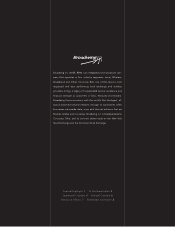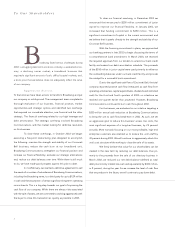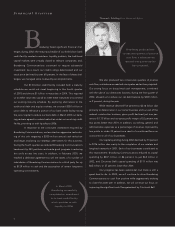Cincinnati Bell 2002 Annual Report Download - page 4
Download and view the complete annual report
Please find page 4 of the 2002 Cincinnati Bell annual report below. You can navigate through the pages in the report by either clicking on the pages listed below, or by using the keyword search tool below to find specific information within the annual report.
To Our Shareholders
roadwing faced serious challenges during
2002: a struggling telecommunications industry; a weakened econ-
omy; a declining carrier market; a broadband business that
required a significant amount of cash; difficult capital markets; and,
a stock price that we believe does not adequately reflect the value
of our company.
Aggressive Actions
To that end, we have taken actions to transform Broadwing and put
our company on solid ground. The management team completed a
thorough evaluation of our business, financial position, market
opportunities and strategic options and identified two overhangs
that required our immediate attention, one financial and the other
strategic. The financial overhang related to our high leverage and
debt amortization. The strategic overhang involved Broadwing
Communications, with the market looking for definitive resolution
on this business.
To clear these overhangs, in October 2002 we began
executing a five-point restructuring plan designed to accomplish
the following: maintain the strength and stability of our Cincinnati
Bell business; reduce the cash burn at our broadband unit,
Broadwing Communications; strengthen our financial position and
increase our financial flexibility; evaluate our strategic alternatives;
and, reduce our debt balances over time. While there is still much
to do, we have made good progress against this plan to date.
In mid-February, we reached a definitive agreement to sell
the assets of a number of subsidiaries of Broadwing Communications,
including the Broadwing name, to a third party for up to $129 million
in cash and the assumption of certain significant long-term operating
commitments. This is a big step towards our goal of improving the
cash flow of our company. While there are always risks associated
with the sale of assets, we are committed to working aggressively with
the buyer to close this transaction as quickly as possible in 2003.
To clear our financial overhang, in December 2002 we
announced that we secured a $200 million commitment of junior
capital to improve our financial flexibility. In January 2003, we
increased that funding commitment to $350 million. This is a
significant commitment of capital in the current environment and
we believe that it speaks directly to the strength and stability of our
Cincinnati Bell business.
With the financing commitment in place, we approached
our banking partners in late 2002 to begin discussing the terms of
a comprehensive bank amendment. In March 2003, we received
the required approvals from our lenders to amend our bank credit
facility and extend our debt amortization schedule. The proceeds
of the $350 million in junior capital were used primarily to refinance
the outstanding balances under our bank credit facility and provide
the catalyst for a successful bank amendment.
Due to the significant cash flow of Cincinnati Bell, the total
company reported positive cash flow (measured as cash flow from
operating activities less capital expenditures, dividends and restricted
cash) for the third and fourth quarters of 2002—a milestone we
reached one quarter earlier than projected. However, Broadwing
Communications continued to burn cash throughout 2002.
For that reason, we embarked on an initiative targeting a
$200 million annual cash reduction at Broadwing Communications
to bring the unit to cash flow break-even in 2003. As such, we set
an aggressive goal to reduce this business’ access line costs, the
most significant expense of a long-haul business, by 25 percent
annually. More narrowly focusing on our most profitable, high-end
enterprise customers also enabled us to reduce this unit’s staff by
30 percent during 2002. We will continue to aggressively attack this
unit’s cost structure while working to close the sale of its assets.
We firmly believe that value for our shareholders can be
created in the near term by reducing our debt balances. Due pri-
marily to the proceeds from the sale of our directory business in
March 2002, we reduced our net debt balance (defined as total
debt plus minority interest less cash and equivalents) by $300 million,
or 9 percent, during the year. As we increase the level of cash flow
that we produce in the future, we will continue to pay down debt.
B
2














